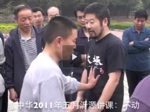You are on the right learning path. The path is very long and at different stages you have to do different things. Usually a person goes through three stages/plateaus. Each one is longer than the previous one.
- The first plateau
- Time required to reach this level: 3 months to a year.
- Contents: foundations and yilu.
- Time you probably will stay at this stage: roughly the same: 3 months to a year before you can learn again.
- The second plateau
- Time required to reach this level: 3 years.
- Contents: Adding Cannon Fist, weapons and push hands. That’s also the time you make substantial progress. You will have normal taiji skills and you think you can handle most situation. You are very good. But there is no magic.
- Time you probably will stay at this stage: roughly 3 to 7 years.
- The third plateau
- This is more elusive. Most often it happens around 7-8 years. For most people this is where learning/progress stops totally. This is also the time new styles are created. There is simply nothing more to learn within the same situations (same master, same routines, same type of training, etc.).
- The final destination
- This is only available to a few select people.
- This is the nature of the art.
- This is the stage when you get the magic: power, speed, size, and nothing is relevant. You have taiji and nothing else.



{ 16 comments… read them below or add one }
What does it take to make it through the third plateau?
Stay the course. This means continue to focus on the same movements, principles and ways of practice, no matter what. This is the time everything is boring. This is the time you will deviate (come up with your own versions of understanding and create new styles). From 1988 to 2002 I virtually made no progress but if you take a look at my video footage from those years, I talked the same talk (correct instructions) but the body continued to make the same mistakes. By keeping the same talk to myself and students, I started to change to taiji by 2002-2005. That period of time was probably the second stage.
Thanks, Master Chen. I have a rough idea of the process of learning taiji after reading your post.
I have hit a plateau in my progress and it is in the second stage. There is no “magic”.
I often wonder what it is I have to do in my training to get to the next level, lots of Yilu, more foundations, pole shaking, rubber band training, etc.
I guess the answer is be patient, follow the rules, train hard and follow the course….it’s a long journey!
As far as I know, the few masters who “GOT IT” also were humiliated to the extent of almost giving up. It happened to me in 1996.
Thank you Master Chen.. This is one of those posts that is worth saving, printing off and hanging on my wall for future talks I will need to have with myself…also, an excellent road map, accompanied with the rules, to “stay the course”…
i am attempting to find my way onto the first road….learning yilu from video….any advice would be greatly appreciated…. http://www.youtube.com/watch?v=PXbt_RLscFw
practice practice practice, and don’t forget about the foundation exercises. It’s easy to underestimate them.
Also, once the form is learned, doesn’t hurt to take a video of yourself and compare it to what you see on the yilu video. It lets you get a 3rd person view of yourself, which is quite helpful. It shows how far off we really are compared to what we see if the yilu video, even though we ‘think’ it feels correct.
yes thanks…the video is extremely helpful… i can see many mistakes already… will do
Master Chen,
this is Jervis,
may i ask, how did you overcome yourself when you saw the “devil”??
I was not smart enough to know these things. I just kept on going.
sorry but i’m not sure if this is the right place to post. how do we integrate body conditioning exercise (HIT training, weights etc) with learning tai chi? are they inherently incompatible? because my previous experience in taichi i was told not to do any weights, or any exercise that tense up the muscles etc. can anyone with more experience advise? thanks!
stoinz,
Perhaps you can give up weights for doing our yilu with a lot of strength/power. You’ll see that it can be a much tougher training than weight lifting. Also i recommend you check the exercise “push the wall”.
Generally weight lifting creates a disproportional muscle structure, which is only good for lifting weights… So unless you wanna have the ‘kungfu’ of weight lifting, i’d say drop that.
You don’t learn to ride a bike by studying math.
Just a hint. 😉
personally i get a lot of tai chi strength benefit from push the wall exercise and man, you need motivation for it
Taiji strength is whole body strength, so it is more tendon/fascia based. To train this deeper connections, you need to do more stretching action which can be seen in the yilu from Ottawa workshop demo video https://www.youtube.com/watch?v=Tj8Sx1lzGV4
Great article